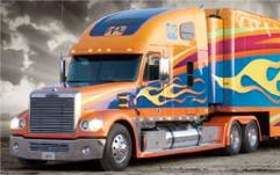Sliding Tandems
Topic 1159 | Page 1
I always make it evenly balanced. You don't want to be too heavy on one set of tandems. For example, you don't want to be 25k on drive axles and 32k on trailer axles. You want to be more like 29k and 28k, just an example. If you have too much weight on the trailer axles and not enough on the drives than the drivers are more vulnerable to sliding. I always prefer to keep them balanced. And if you're 31k on drives and 33.5k on trailer axles then you'll have to go through every weigh station but if you balance it out at 32k each then you'll more likely get a green light on your prepass.
Basically, I always balance it out. But you have to keep in mind the kingpin setting for all the states. For example if you're at the maximum 40' kingpin setting allowed in Ca and you want to move them back (give more weight to drive axles) then you can't because you're at the maximum kingpin setting - in that case you can no longer balance it completely so you just take what you can get even if the trailer axles are a lot heavier than the drives.
Tandems:
Tandem Axles
A set of axles spaced close together, legally defined as more than 40 and less than 96 inches apart by the USDOT. Drivers tend to refer to the tandem axles on their trailer as just "tandems". You might hear a driver say, "I'm 400 pounds overweight on my tandems", referring to his trailer tandems, not his tractor tandems. Tractor tandems are generally just referred to as "drives" which is short for "drive axles".
Tandem:
Tandem Axles
A set of axles spaced close together, legally defined as more than 40 and less than 96 inches apart by the USDOT. Drivers tend to refer to the tandem axles on their trailer as just "tandems". You might hear a driver say, "I'm 400 pounds overweight on my tandems", referring to his trailer tandems, not his tractor tandems. Tractor tandems are generally just referred to as "drives" which is short for "drive axles".
Awesome answer from Daniel. He's right on.
The two concerns with balancing the load are getting it legal and making it safe. The reason the axle limits exist (in no particular order):
1) Prevent damage to the roadways from too much pressure on the roadway in a small area
2) Prevent overloading the truck suspension or tires and risking a failure
3) To evenly distribute the weight so you have equal grip on all tires. This will help prevent tires from skidding due to braking force or side force in a curve.
So indeed it is best from a safety, performance, and compliance standpoint to get your drive tandems and trailer tandems evenly balanced. But you don't have to go overboard with this either. Having a difference of 1 or 2 thousand pounds won't make too much of a difference when it comes to safety. And often times the balance you can achieve is limited by the weight distribution of the load or the bridge laws (as Daniel mentioned).
So don't obsess over it, but try to get it reasonably close to balanced. The closer the better.
Tandems:
Tandem Axles
A set of axles spaced close together, legally defined as more than 40 and less than 96 inches apart by the USDOT. Drivers tend to refer to the tandem axles on their trailer as just "tandems". You might hear a driver say, "I'm 400 pounds overweight on my tandems", referring to his trailer tandems, not his tractor tandems. Tractor tandems are generally just referred to as "drives" which is short for "drive axles".
Tandem:
Tandem Axles
A set of axles spaced close together, legally defined as more than 40 and less than 96 inches apart by the USDOT. Drivers tend to refer to the tandem axles on their trailer as just "tandems". You might hear a driver say, "I'm 400 pounds overweight on my tandems", referring to his trailer tandems, not his tractor tandems. Tractor tandems are generally just referred to as "drives" which is short for "drive axles".

You could just become a tanker yanker and not have to worry about sliding tandems.  Liquid balances itself so I don't have to worry about axle weights.
Liquid balances itself so I don't have to worry about axle weights.
Tandems:
Tandem Axles
A set of axles spaced close together, legally defined as more than 40 and less than 96 inches apart by the USDOT. Drivers tend to refer to the tandem axles on their trailer as just "tandems". You might hear a driver say, "I'm 400 pounds overweight on my tandems", referring to his trailer tandems, not his tractor tandems. Tractor tandems are generally just referred to as "drives" which is short for "drive axles".
Tandem:
Tandem Axles
A set of axles spaced close together, legally defined as more than 40 and less than 96 inches apart by the USDOT. Drivers tend to refer to the tandem axles on their trailer as just "tandems". You might hear a driver say, "I'm 400 pounds overweight on my tandems", referring to his trailer tandems, not his tractor tandems. Tractor tandems are generally just referred to as "drives" which is short for "drive axles".

You could just become a tanker yanker and not have to worry about sliding tandems.
Liquid balances itself so I don't have to worry about axle weights.
So if your carrying 2000 lbs of diesel fuel #1 and 2500 lbs of diesel #2 we can expect and new mixture of who knows what?
Just kidding not all tankers have no baffles .
Baffle:
A partition or separator within a liquid tank, used to inhibit the flow of fluids within the tank. During acceleration, turning, and braking, a large liquid-filled tank may produce unexpected forces on the vehicle due to the inertia of liquids.Tandems:
Tandem Axles
A set of axles spaced close together, legally defined as more than 40 and less than 96 inches apart by the USDOT. Drivers tend to refer to the tandem axles on their trailer as just "tandems". You might hear a driver say, "I'm 400 pounds overweight on my tandems", referring to his trailer tandems, not his tractor tandems. Tractor tandems are generally just referred to as "drives" which is short for "drive axles".
Tandem:
Tandem Axles
A set of axles spaced close together, legally defined as more than 40 and less than 96 inches apart by the USDOT. Drivers tend to refer to the tandem axles on their trailer as just "tandems". You might hear a driver say, "I'm 400 pounds overweight on my tandems", referring to his trailer tandems, not his tractor tandems. Tractor tandems are generally just referred to as "drives" which is short for "drive axles".

Ya got me there. Most of our trailers are unbaffled one compartment trailers, but we have some 2, 3, and 4 compartment trailers. I just haven't pulled any yet, but you are right, it would matter in that situation especially because some of this stuff is very dense.
I guess I'll report back when I pull a trailer with a forward compartment that holds like 4000 gallons and I am loaded with something that weighs 8 or more pounds per gallon.
Baffle:
A partition or separator within a liquid tank, used to inhibit the flow of fluids within the tank. During acceleration, turning, and braking, a large liquid-filled tank may produce unexpected forces on the vehicle due to the inertia of liquids.
Just remember when sliding tandems where you are traveling to/through. Some states have requirements for tandem placement, California being the most restrictive (go figure!). I have had loads that were impossible to balance without removing or reloading. When you have to go back to the shipper and ask them to do that, you are not generally going to be received well.
I did end up pulling a load with 4.5K more weight on the trailer tandems as opposed to the drive wheels.... it was an SLSC (shipper load, shipper count) load, and the shipper was pretty unreasonable. The Cat scale weighed out for me and the shipper just did not want to change it. I ended up pulling it because I was overall about 8K under max weight. I probably wouldn't do it again, but the receiver was one of our very good clients and I did not want to be late on the load.
I would not advise it, but it can be done. Don't push the max weight on drive or trailer trandems if unbalanced.
I did have a crappy trailer once that I just couldn't move the tandems on, despite hammering on pins, soaping the heck out of the rails, etc. They were set for California so I left them, and was a couple thousand pounds heavy on the drive wheels.
At least that is my advice. The more experienced guys are probably better sources.
Shipper:
The customer who is shipping the freight. This is where the driver will pick up a load and then deliver it to the receiver or consignee.
Tandems:
Tandem Axles
A set of axles spaced close together, legally defined as more than 40 and less than 96 inches apart by the USDOT. Drivers tend to refer to the tandem axles on their trailer as just "tandems". You might hear a driver say, "I'm 400 pounds overweight on my tandems", referring to his trailer tandems, not his tractor tandems. Tractor tandems are generally just referred to as "drives" which is short for "drive axles".
Tandem:
Tandem Axles
A set of axles spaced close together, legally defined as more than 40 and less than 96 inches apart by the USDOT. Drivers tend to refer to the tandem axles on their trailer as just "tandems". You might hear a driver say, "I'm 400 pounds overweight on my tandems", referring to his trailer tandems, not his tractor tandems. Tractor tandems are generally just referred to as "drives" which is short for "drive axles".
CAT Scale:
A network of over 1,500 certified truck scales across the U.S. and Canada found primarily at truck stops. CAT scales are by far the most trustworthy scales out there.
In fact, CAT Scale offers an unconditional Guarantee:
“If you get an overweight fine from the state after our scale showed your legal, we will immediately check our scale. If our scale is wrong, we will reimburse you for the fine. If our scale is correct, a representative of CAT Scale Company will appear in court with the driver as a witness”

I always try to balance the weight as much as possible like others have mentioned but I have one exception. In the winter, if I know the roads are a bit crappy, I will put more weight on my drive tires.
In the winter, if I know the roads are a bit crappy, I will put more weight on my drive tires.
That's good if you're accelerating, but trailer brakes tend to clamp down sooner and sometimes a bit harder than drive tires. So it's hard to say if that's good or not. It's a good example of how almost every decision is a compromise of some sort. It can help you in some ways and hurt you in others.
New Reply:
New! Check out our help videos for a better understanding of our forum features

















Preview:








 TT On Facebook
TT On Facebook
I am doing the Weight and Balance section.
Pretty simple if you have a decent working knowledge of math.
When moving the tandems , does it matter about getting the load close to balanced or just making it legal.
For example. If moving 3 holes gets you legal, but 4 holes will balance the load better, does it matter if you move that extra hole?
Keep it safe out there. Joe S
Tandems:
Tandem Axles
A set of axles spaced close together, legally defined as more than 40 and less than 96 inches apart by the USDOT. Drivers tend to refer to the tandem axles on their trailer as just "tandems". You might hear a driver say, "I'm 400 pounds overweight on my tandems", referring to his trailer tandems, not his tractor tandems. Tractor tandems are generally just referred to as "drives" which is short for "drive axles".
Tandem:
Tandem Axles
A set of axles spaced close together, legally defined as more than 40 and less than 96 inches apart by the USDOT. Drivers tend to refer to the tandem axles on their trailer as just "tandems". You might hear a driver say, "I'm 400 pounds overweight on my tandems", referring to his trailer tandems, not his tractor tandems. Tractor tandems are generally just referred to as "drives" which is short for "drive axles".